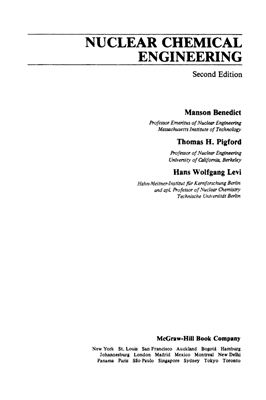Second Edition, McGraw-Hill, New York, San Francisco, Hamburg,
1981, 1078 pp. - ISBN 0-07-004531-3.
The development of nuclear fission chain reactors for the conversion of mass to energy and the transmutation of elements has brought into industrial prominence chemical substances and chemical engineering processes that a few years ago were no more than scientific curiosities. Uranium, formerly used mainly for coloring glass and ceramics, has become one of the world's most important sources of energy. Thorium, once used mainly in the Welsbach gas mantle, promises to become a nuclear fuel second in importance only to uranium. Zirconium and its chemical twin hafnium, formerly always produced together, have been separated and have emerged as structural materials of unique value in reactors…
Contents.
Preface.
1 Chemical Engineering Aspects of Nuclear Power.
2 Nuclear Reactions.
3 Fuel Cycles for Nuclear Reactors.
4 Solvent Extraction of Metals.
5 Uranium.
6 Thorium.
7 Zirconium and Hafnium.
8 Properties of Irradiated Fuel and Other Reactor Materials.
9 Plutonium and Other Actinide Elements.
10 Fuel Reprocessing.
11 Radioactive Waste Management.
12 Stable Isotopes: Uses, Separation Methods, and Separation Principles Uses of Stable Isotopes.
13 Separation of Isotopes of Hydrogen and Other Light Elements.
14 Uranium Isotope Separation.
Appendixes. Index
The development of nuclear fission chain reactors for the conversion of mass to energy and the transmutation of elements has brought into industrial prominence chemical substances and chemical engineering processes that a few years ago were no more than scientific curiosities. Uranium, formerly used mainly for coloring glass and ceramics, has become one of the world's most important sources of energy. Thorium, once used mainly in the Welsbach gas mantle, promises to become a nuclear fuel second in importance only to uranium. Zirconium and its chemical twin hafnium, formerly always produced together, have been separated and have emerged as structural materials of unique value in reactors…
Contents.
Preface.
1 Chemical Engineering Aspects of Nuclear Power.
2 Nuclear Reactions.
3 Fuel Cycles for Nuclear Reactors.
4 Solvent Extraction of Metals.
5 Uranium.
6 Thorium.
7 Zirconium and Hafnium.
8 Properties of Irradiated Fuel and Other Reactor Materials.
9 Plutonium and Other Actinide Elements.
10 Fuel Reprocessing.
11 Radioactive Waste Management.
12 Stable Isotopes: Uses, Separation Methods, and Separation Principles Uses of Stable Isotopes.
13 Separation of Isotopes of Hydrogen and Other Light Elements.
14 Uranium Isotope Separation.
Appendixes. Index

